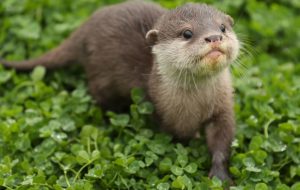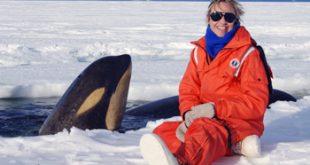Mời các bạn làm bài tập ôn luyện dạng bài Short-answer Questions trong IELTS Reading. Bài tập này giúp các bạn ôn lại kỹ năng xử lý dạng bài Short-answer Questions cũng như củng cố lượng từ vựng. Bài có tất cả 4 câu hỏi điền từ. Sau khi làm xong bài, các bạn hãy ấn submit để xem kết quả bài làm của mình và giải thích của từng câu hỏi. Bạn hãy thử làm để củng cố và nâng cao kiến thức để chuẩn bị cho bài thi IELTS Reading nhé!
Chúc bạn có thời gian hữu ích trên website!
Otters

A Otters are semiaquatic (or in the case of the sea otter, aquatic) mammals. They are members of the Mustelid family which includes badgers, polecats, martens, weasels, stoats and minks, and have inhabited the earth for the last 30 million years and over the years have undergone subtle changes to the carnivore bodies to exploit the rich aquatic environment. Otters have long thin body and short legs—ideal for pushing dense undergrowth or hunting in tunnels. An adult male may be up to 4 feet long and 30 pounds. Females are smaller, around 16 pounds typically. The Eurasian otter’s nose is about the smallest among the otter species and has a characteristic shape described as a shallow “W”. An otter’s tail (or rudder, or stern) is stout at the base and tapers towards the tip where it flattens. This forms part of the propulsion unit when swimming fast under water. Otter fur consists of two types of hair: stout guard hairs which form a waterproof outer covering, and under-fur which is dense and fine, equivalent to an otter’s thermal underwear. The fur must be kept in good condition by grooming. Sea water reduces the waterproofing and insulating qualities of otter fur when salt water gets in the fur. This is why freshwater pools are important to otters living on the coast:. After swimming, they wash the salts off in the pools and then squirm on the ground to rub dry against vegetation.
B Scent is used for hunting on land, for communication and for detecting danger. Otterine sense of smell is likely to be similar in sensitivity to dogs. Otters have small eyes and are probably short-sighted on land. But they do have the ability to modify the shape of the lens in the eye to make it more spherical, and hence overcome the refraction of water. In clear water and good light, otters can hunt fish by sight. The otter’s eyes and nostrils arc placed high on its head so that it can see and breathe even when the rest of the body is submerged. The long whiskers growing around the muzzle are used to detect the presence of fish. They detect regular vibrations caused by the beat of the fish’s tail as it swims away. This allows otters to hunt even in very murky water. Underwater, the otter holds its legs against the body, except for steering, and the hind end of the body is flexed in a series of vertical undulations. River otters have webbing which extends for much of the length of each digit, though not to the very end. Giant otters and sea otters have even more prominent webs, while the Asian short-clawed otter has no webbing—they hunt for shrimps in ditches and paddy fields so they don’t need the swimming speed. Otter ears are protected by valves which close them against water pressure.
C A number of constraints and preferences limit suitable habitats for otters. Water is a must and the rivers must be large enough to support a healthy population of fish. Being such shy and wary crea-tures, they will prefer territories where man’s activities do not impinge greatly. Of course, there must also be no other otter already in residence—this has only become significant again recently as populations start to recover. A typical range for a male river otter might be 25km of river, a female’s range less than half this. However, the productivity of the river affects this hugely and one study found male ranges between 12 and 80km. Coastal otters have a much more abundant food supply and ranges for males and females may be just a few kilometers of coastline. Because male ranges are usually larger, a male otter may find his range overlaps with two or three females. Otters will eat anything that they can get hold of—there are records of sparrows and snakes and slugs being gobbled. Apart from fish the most common prey are crayfish, crabs and water birds. Small mammals are occasionally taken, most commonly rabbits but sometimes even moles.
D Eurasian otters will breed any time where food is readily available. In places where condition is more severe, Sweden for example where the lakes are frozen for much of winter, cubs are bom in Spring. This ensures that they are well grown before severe weather returns. In the Shetlands, cubs are born in summer when fish is more abundant. Though otters can breed every year, some do not. Again, this depends on food availability. Other factors such as food range and quality of the female may have an effect. Gestation for Eurasian otter is 63 days, with the exception of North American river otter whose embryos may undergo delayed implantation.
E Otters normally give birth in more secure dens to avoid disturbances. Nests are lined with bedding (reeds, waterside plants, grass) to keep the cubs warm while mummy is away feeding. Litter Size varies between 1 and 5 (2 or 3 being the most common). For some unknown reason, coastal otters tend to produce smaller litters. At five weeks they open their eyes—a tiny cub of 700g. At seven weeks they’re weaned onto solid food. At ten weeks they leave the nest, blinking into daylight for the first time. After three months they finally meet the water and learn to swim. After eight months they are hunting, though the mother still provides a lot of food herself. Finally, after nine months she can chase them all away with a clear conscience, and relax—until the next fella shows up.
F The plight of the British otter was recognised in the early 60s, but it wasn’t until the late 70s that the chief cause was discovered. Pesticides, such as dieldrin and aldrin, were first used in ‘1955 in agriculture and other industries—these chemicals are very persistent and had already been recognised as the cause of huge declines in the population of peregrine falcons, sparrowhawks and other predators. The pesticides entered the river systems and the food chain—micro-organisms, fish and finally otters, with every step increasing the concentration of the chemicals. From 1962 the chemicals were phased out, but while some species recovered quickly, otter numbers did not—and continued to fall into the 80s. This was probably due mainly to habitat destruction and road deaths. Acting on populations fragmented by the sudden decimation in the 50s and 60s, the loss of just a handful of otters in one area can make an entire population enviable and spell the end.
G Otter numbers are recovering all around Britain—populations are growing again in the few areas where they had remained and have expanded from those areas into the rest of the country. This is almost entirely due to law and conservation efforts, slowing down and reversing the destruction of suitable otter habitat and reintroductions from captive breeding programs. Releasing captive-bred otters is seen by many as a last resort. The argument runs that where there is no suitable habitat for them they will not survive after release and when1 there is suitable habitat;, natural populations should be able to expand into the area. However, reintroducing animals into a fragmented and fragile population may add just enough impetus for it to stabilise and expand, rather than die out. This is what the Otter Trust accomplished in Norfolk, where the otter population may have been as low as twenty animals at the beginning of the 1980s. The Otter Trust has now finished its captive breeding program entirely. Great news because it means it is no longer’ needed.
Questions 1-4
Answer the questions below.
Choose NO MORE THAN TWO WORDS from the passage for each answer.
Write your answers in boxes 1-4 on your answer sheet.
What affects the outer fur of otters?
1
What skill is not necessary for Asian short-clawed otters?
2
Which type of otters has the shortest range?
3
Which type of animals do otters hunt occasionally?
4
 IELTS Max Luyện thi IELTS cam kết đầu ra
IELTS Max Luyện thi IELTS cam kết đầu ra




